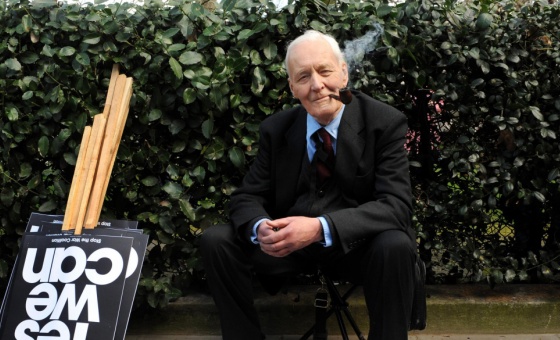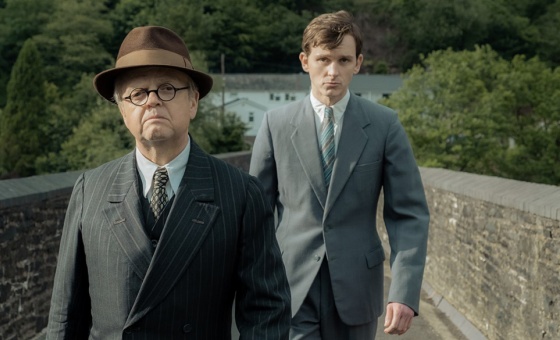This is the last article you can read this month
You can read more article this month
You can read more articles this month
Sorry your limit is up for this month
Reset on:
Please help support the Morning Star by subscribing here
FRUSTRATED with watching Margaret Thatcher’s war on the miners from afar, Mark Ashton flicks through a well-thumbed phone book.
After finding “somewhere northern, industrial,” he calls to offer desperately needed cash for the strike fund but is cut off at the first mention of Lesbians and Gays Support the Miners.
So the rejections continue — until he dials the number for Onllwyn Miners Welfare Hall and, to his relief, hears kindly grandma Gwen.
The rest is history, as told by Pride, which was last week nominated for Bafta’s Outstanding British Film.
Well, not quite.
“There was a phone call,” says Hywel Francis, then chair of the Neath, Dulais and Swansea Valleys Miners Support Group.
“It was from the Communist Party to me as a member.
“The Communist Party played a big role in this, Mark Ashton in particular as general secretary of the Young Communist League.
“It was not an accident as the film portrays. It was actually not contrived but worked at, building an alliance of this kind.”
Details like that, however, do not make for a fairy tale start to a film that was meant to awaken a new audience to the power of an old concept — solidarity.
Speaking to the Star in his parliamentary office, seated in front of a photo of his father, Welsh miners’ leader Dai Francis, he’s not bitter about the compromise, saying it will have a “positive impact” on perceptions of the period.
“Mark Ashton’s politics should have been more evident,” he says.
“But I’m a historian not a scriptwriter, so I can understand why he (writer Stephen Beresford) did it for dramatic effect. They have licence to do that.”
As a historian, Francis equally has licence to distinguish between events invented for dramatic effect and the real lived experience of miners, their families and supporters through the historic 1984-5 strike.
He’s recently been poring through minutes of local Miners Support Group meetings as well as records of Lesbians and Gays Support the Miners and plans to publish a new chapter of his book, History on Our Side, in March.
“The film has focused the minds of historians about the need to have a proper history of that period,” he says.
Francis is particularly keen to set the record straight about one thing: “There was no hostility to the link which we established.
“We were a highly political support group and we welcomed the relationship,” he adds.
“The overt homophobia that was clear at the beginning of the film didn’t exist and neither did the meeting where the relationship was severed.”
Sian James, who’s central contribution to this solidarity story was portrayed in Pride, admits plainly though that “it was a real clash of cultures.”
“We had gay men and women visiting who lived very exotic lives in comparison to us. They dressed differently, some of them were very flamboyant,” James remembers.
That clash is really rammed home in Pride’s trailer, which opens with the words: “In a small Welsh mining village deep in the valleys, the locals are about to get the surprise of their lives.”
I ask if, beyond the sartorial, there’s an implication in the film that Ashton and fellow LGSM members were responsible for importing socially progressive ideas to south Wales?
James says their new comrades “didn’t educate us politically, because that was already there.”
She explains that they instead “opened our eyes to something we’d found very easy to ignore in the past — that a lot of other groups were getting it bad.
“All of these people were interesting and different but we had one thing in common, we were all socialists and we all hated Margaret Thatcher.
“That’s what I took from people coming in.”
If the start of this inspirational story was not as accidental as it seemed, the spark for the latest chapter certainly was a coincidence.
The 2013 funeral of Miners Support Group secretary Hefina Headon, played by Imelda Staunton in Pride, brought James and Francis back together with LGSM stalwart Mike Jackson at the very time the film was being shot.
Without each other knowing, both support groups had been planning to re-form for the the 30th anniversary of the miners’ strike.
Now they’re planning to reunite and party like it’s 1985 at the Onllwyn Miners Welfare Hall.
The parties held at the hall during the strike inspired the title for Dancing in Dulais — the name of LGSM’s documentary of the period — and the raucous disco scene in Pride, which sees Jonathan Blake, played by Dominic West, wowing the women and winning over the men with his dance moves.
Francis promises that the reunion, with tunes provided by Dulais Valley Divas and Pride star Bronwen Lewis, will “be just like a night during the strike.”
Those events reimagined by Pride, which has undoubtedly made the miners’ strike real and relevant to a new generation, will continue to be contested.
Official history books will document that the strike to save the pits was lost — but there’s no doubt that, 30 years on, the two groups and their incredible solidarity story is helping to write the people’s history of that strike.









